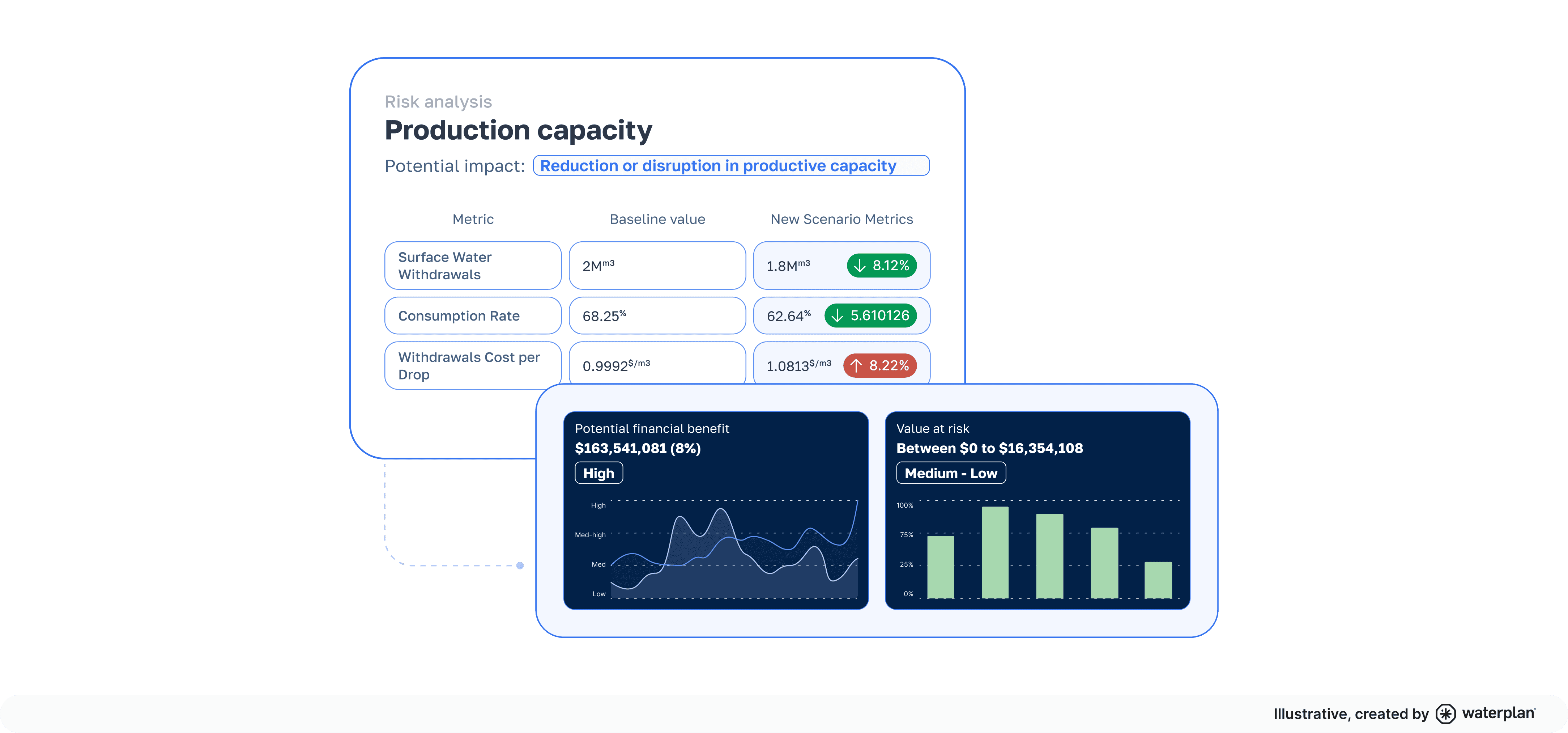Summary
Corporate sustainability and EHS managers face growing pressure to deliver more—more accurate insights, more stakeholder alignment, more measurable impact—while navigating limited time, complex internal dynamics, and evolving external requirements. When it comes to water risk, this challenge becomes especially acute.
Managing water data across global operations is not just a technical task—it’s a high-stakes process that requires coordination across sites, consolidation of diverse data formats, and the ability to respond quickly to risks, all while preparing for audits, regulatory reviews, and disclosure deadlines.
Waterplan is built to make that process seamless. From data gathering to scenario modeling, target tracking to reporting, our platform supports the full arc of a company’s water stewardship journey. What follows is a breakdown of the key features that make that possible—and how they help you move from scattered effort to streamlined execution.
Centralized Data, Always Up to Date
At the core of Waterplan’s value is its ability to consolidate all relevant water data in one place. The platform integrates and updates high-quality local data and site-specific assessments from a wide range of sources—satellite imagery, IoT sensors, GRACE and GLoFAS datasets and public basin plans.
Companies typically have to fly out employees to sites to consolidate spreadsheet data, PDFs, images, and other varying formats. Rather than relying on disconnected spreadsheets or delayed data collection cycles, Waterplan ensures that all stakeholders—from local facility managers to global sustainability leads—have access to the same, continuously refreshed insights. This removes friction in decision-making, ensures alignment across teams, and reduces the risk of acting on outdated or incomplete information. It also saves companies a lot of time and money!

Dynamic Scenario Modeling and Financial Quantification
Understanding a risk is only the first step. Acting on it requires being able to quantify its potential impact—on operations, budgets, and long-term business continuity. Waterplan’s AI-powered scenario modeling draws on data gathered to identify site vulnerabilities, allowing teams to simulate potential risk scenarios and estimate the financial implications of inaction or delay.
This helps sustainability and EHS managers build clear business cases for mitigation strategies. Whether it’s justifying investments in water treatment infrastructure or implementing conservation projects, scenario modeling transforms risk data into tangible, actionable insights that can drive budget allocation and executive decision-making.

Site-Specific Contextual Target Setting
Not all sites face the same risks, and not all targets should be the same. Waterplan’s risk framework enables the development of contextual water targets tailored to the context and regulatory landscape of each site.
With access to detailed water data, local vulnerability assessments, dynamic risk scores, and Waterplan’s expert water advisors, companies can set meaningful, location-specific goals for water use, treatment, and reuse. These targets aren’t abstract—they are grounded in the local context and aligned with global sustainability frameworks. This empowers site managers to own the goals, while enabling corporate teams to monitor and support them from a central platform.

Clear and Continuous Target Tracking
Tracking progress against water targets can be one of the most difficult parts of implementing a water strategy—especially when each site operates under different conditions and collects data differently. Waterplan simplifies this by enabling companies to set, monitor, and update contextual water targets directly within the platform.
Whether the goal is reducing freshwater withdrawals, improving discharge quality, or increasing water reuse, targets are linked to risk assessments and mitigation actions. The platform regularly updates site-level data, ensuring that goals remain relevant and achievable over time. With dynamic dashboards and real-time progress visibility, teams can align on shared objectives and demonstrate clear accountability across regions.
This centralization reduces reporting errors, increases transparency, and ensures that progress toward water goals becomes measurable, manageable, and repeatable.

A Network of Vetted Implementation Partners
Effective water stewardship doesn’t end with insights—it requires action on the ground. Waterplan connects organizations with a global network of trusted implementation partners who specialize in delivering measurable water impact. These partners bring local expertise to design and execute high-impact projects, from wetland restoration to infrastructure upgrades.
Through this network, companies can confidently pursue replenishment goals and Volumetric Water Benefit (VWB) generation, knowing they’re working with credible teams aligned with sustainability standards. All project data is tracked within the Waterplan platform, ensuring visibility into progress, impact, and outcomes.

Streamlined, Audit-Ready Reporting
One of the most time-consuming aspects of sustainability work is reporting. Waterplan significantly reduces this burden by automating the creation of reporting-ready outputs that align with leading disclosure frameworks, including CDP Water Security, SBTi, CSRD, TCFD, SASB, GRI, and ISSB.
Instead of pulling information from scattered sources and formatting it manually, teams can export structured, audit-ready reports at the click of a button. For organizations with frequent internal and external reporting requirements, this alone can save hundreds of hours each year—and improve the consistency, accuracy, and defensibility of disclosed data.

Designed for Annual Recurrence
Water risk is not static—it changes with climate variability, operational shifts, community dynamics, and evolving regulations. That’s why Waterplan is structured around an annual license that supports recurring assessments and continuous monitoring.
This model aligns with key reporting cycles (such as ISO certification schemes and CDP submissions), while allowing for course corrections and updates throughout the year. For companies aiming to stay ahead of regulatory trends and evolving ESG expectations, an annual cadence ensures that water strategies remain current, effective, and resilient over time.
Scalable Across Regions, Teams, and Operations
Many sustainability leaders struggle to implement consistent water risk strategies across complex global operations. Different sites often use different methodologies, track different metrics, or face wildly different local realities.
Waterplan solves this by offering a standardized framework that is flexible enough to accommodate local nuance, but consistent enough to enable global oversight. All sites, regardless of location, can be monitored using the same tools and performance criteria—creating a unified approach that scales effectively across geographies, facilities, and business units.

Supported by a Team of Water Experts
Beyond the technology, Waterplan offers hands-on support from a team of senior water advisors with deep expertise in both global and local water issues. These experts help teams interpret complex data, prioritize interventions, and navigate nuanced regulatory landscapes, among others.
This human layer ensures that organizations are not just using software, but building institutional water knowledge and long-term capabilities for sustainable water stewardship. The result is a platform that doesn’t just deliver insights, but delivers outcomes.
Waterplan for Your Water Risk Management
Waterplan is more than a software solution—it’s an integrated system designed to support the full operational and strategic cycle of water risk management. For sustainability and EHS teams, that means less time spent chasing data, fewer iterations with internal stakeholders, and more confidence in every report, target, and mitigation plan.
By centralizing insights, automating reporting, and supporting ongoing decision-making, Waterplan helps companies not just meet compliance requirements, but build momentum across sites, teams, and leadership. The result is a more coordinated, scalable, and credible water strategy—one that keeps you on track, even as risks evolve and expectations rise.
If you're ready to reduce complexity and deliver results that resonate across your organization, Waterplan is ready to help.
Related content
Get insights, expert analysis and tips on measuring, reporting, and responding to water risk





